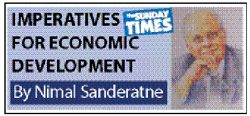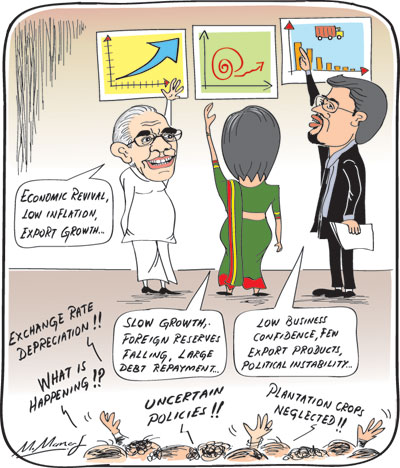Columns
Are the economic fundamentals sound? Strengths and weaknesses of the economy
View(s):Fiscal consolidation, low inflation and export growth are fundamental strengths of the economy. On the other hand, economic growth is slow, foreign indebtedness is high, business confidence is low, export growth is inadequate, foreign investment, though increasing, is inadequate and the large trade deficit is weakening the external finances. The economy is vulnerable owing to the large foreign debt servicing obligations.
 These views of the panellists at the monthly meeting of the Sunday Times Business Club (STBC) on October 17 evoked much discussion and raised many issues on the current economic situation.
These views of the panellists at the monthly meeting of the Sunday Times Business Club (STBC) on October 17 evoked much discussion and raised many issues on the current economic situation.
Fiscal consolidation
Finance State Minister Eran Wickremaratne said that the economy is picking up. The progress towards a revenue enhanced fiscal consolidation was one of the important achievements of the Government, However, he admitted it was a serious challenge to achieve the targets owing to the election year ahead and the adverse international developments, particularly the appreciation of the US dollar and increasing fuel prices.
Serious challenges
The fiscal deficit has been brought down to 5.7 percent last year in spite of the slowing down of GDP growth. A serious challenge is to achieve a fiscal deficit of 4.5 percent this year and move towards the target of 3.5 percent of GDP in 2020.
There have been gains in revenue collection, but containing expenditure in the run-up to elections is a serious challenge for the government. The way out of this dilemma is to curtail wasteful expenditure to finance populist programmes and to contain overall expenditure at budgeted amounts. Eliminating supplementary expenditure is a must in this context.
 Growth
Growth
Minister Wickramaratne said economic growth would increase during the remaining months of the year at a rate higher than the first half of 2018 and that the Government’s policies would enhance exports and investment to facilitate a stronger and sustained growth over the medium term. Further, inflation is low and food prices have decreased.
Dr Dushni Weerakoon, Executive Director of the Institute of Policy Studies, pointed out that economic growth was low in the past six quarters. It was below 4 percent in the second half of last year and in the first half of this year. She was of the view that at best growth this year’s would reach 4 percent.
This weak growth poses difficulties in facing the current external shocks and global financial developments. It weakens the capacity to face the threats of the global financial developments, increasing international fuel prices and the US trade embargos that will impact on the economy in diverse ways.
Low business confidence
Shiran Fernando, Chief Economist of the Ceylon Chamber of Commerce, stressed that the slow growth in the economy was largely due to lack of confidence among investors, both domestic and foreign. He said that indices show low business confidence.
Foreign investors are reluctant to invest when economic fundamentals are weak. Investors gauge the suitability of an investment location by such criteria as foreign indebtedness, level of foreign reserves, exchange rate volatility, policy certainty and political stability. In contrast to Sri Lanka, Vietnam was attracting huge investments from China.
Furthermore, exports are not expanding fast, as there have been very few new products developed. Innovation, Shiran Fernando said, is vital for export expansion.
Currency depreciation
STBC members said that the continuing depreciation of the rupee was a serious impediment for investment and a discouragement to attracting foreign investment.
The appreciating dollar, coupled with increasing international fuel prices, has caused these serious difficulties, especially for emerging countries like Sri Lanka. The rupee depreciation was an inevitable result of the US dollar appreciation and in tandem with the depreciation of the currencies of other countries in the region and elsewhere. The Sri Lankan rupee depreciation was higher than some currencies and lower than others, such as India.
Indian depreciation
The depreciation of the Indian rupee was more than that of the Sri Lankan rupee. It was about 11 percent compared to Sri Lanka’s 9 percent. Since the Indian economy is a less import dependent one, basic living costs are likely to be less affected by the depreciation. Yet, increased prices of petrol have brought hardships and there are protests.
Panellists viewed the Central Bank’s policy of not losing its reserves by trying to defend the currency as correct. Dr Weerakoon said its limited intervention had depleted some of its reserves. Foreign exchange reserves had fallen from nearly 10 billion US dollars to 7.4 billion. These were adequate for only about 4 ½, months of imports and were they to fall to 3 months of imports it would be serious.
Exchange rate
Exchange rate determination is a much misunderstood issue. The Sri Lankan exchange rate must be at a level that ensures competitiveness of our exports in international markets. For quite some time the Sri Lankan Rupee was overvalued and rendered our exports uncompetitive.
What matters is the real effective exchange rate that weights the Sri Lankan Rupee with a basket of competitive currencies. An export oriented economy must have a realistic exchange rate that is arrived at in relation to the real effective exchange rate. Sri Lanka cannot keep its exchange rate stable when other countries are depreciating theirs. An uncompetitive exchange rate would jeopardise the country’s exports and destabilise the economy.
Misconceptions
Exchange rate policy has always been coloured by ideological misconceptions and the impact on domestic prices. The high import dependency means that an exchange rate depreciation increases domestic prices.
This import dependency includes basic necessities like wheat flour, milk, sugar, and dhal and transport costs. Therefore it increases the basic cost of living. Consequently depreciation is unpopular.
Furthermore, manufactured exports have a high import content. Therefore, while the depreciation of the Rupee enhances export incomes, it also increases the costs of imported inputs of manufactured exports.
Pragmatism
The need to adopt pragmatic economic policies was stressed by State Minister Wickremaratne. He pointed out instances of a lack in pragmatism in economic policies. He said economic policies that had been a success could be replicated. The joint ventures of two container trans-shipment terminals under previous governments were a success that could be replicated. The inability to divest non-performing state enterprises, too, was illustrative of not being pragmatic.
Vietnam
Countries like Vietnam had succeeded owing to their adoption of pragmatic policies. Dr Weerakoon pointed out that Vietnam was able to adopt pragmatic economic policies as it was an autocratic state. Sri Lanka’s political context was very different.
Neglect of agriculture
STBC members pointed out that the neglect of tea, rubber and coconut, for which the country had an international comparative advantage, was a serious flaw. While the diminishing relative contribution of agriculture was indicative of the diversification of the economy and a feature of economic development, the diminished production and productivity of plantation crops was a serious flaw.
Summing up
Although the fiscal situation has improved, exports are growing and inflation is low, the large foreign debt and high debt servicing costs pose serious economic challenges.
The economy is in a vulnerable position as it has not performed adequately and several economic fundamentals are weak.


Leave a Reply
Post Comment